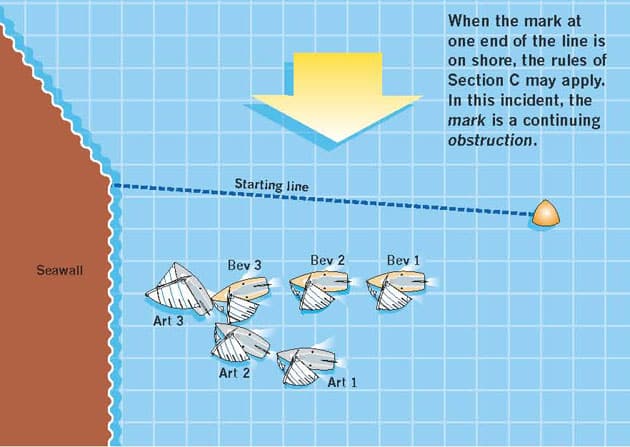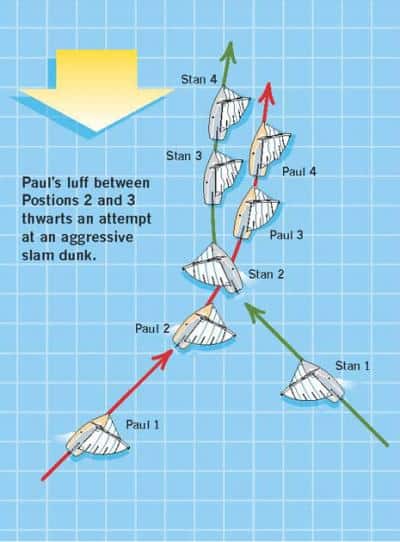The Preamble to Section C tremendously simplifies the rules at most starts by “switching off” all Section C rules at a starting mark when the mark is surrounded by navigable water and you are on your final approach to the line to start. What happens in those rare circumstances when one end of the starting line is on shore or on the end of a pier?

Kim Downing
In US Appeal 71, the starting line is between a flagpole on a seawall and a mark set offshore. Art and Bev, sailing agile keelboats, are beam reaching below the line toward the seawall. As shown in the diagram above, Art was clear ahead when he reached a point three lengths from the seawall. He luffed to a closehauled course, and that put him on a collision course with Bev. There were two ways that Bev could respond to avoid a collision—by luffing or by bearing away. She thought that if she luffed she might cross the line too soon, so she bore away. She miscalculated and her bow hit Art’s starboard side near the stern causing damage. Both boats protested—Art under the second sentence of Rule 18.2(b) for Bev’s failure to give him mark-room, and Bev under Rule 16.1 claiming that Art failed to give her room to keep clear when he luffed.
The appeals committee’s decision may surprise you. First, they pointed out that the seawall at the inshore end of the line was both a mark and a continuing obstruction. Citing Rule 18.1(d), they pointed out that Rule 19.2(b) and not Rule 18 applied to the boats at the seawall. Moreover, Rule 19.2(b) did not begin to apply until the boats were overlapped and “at” the seawall.
Art had right of way over Bev at all times, first as a clear ahead boat under Rule 12, and later as a leeward boat under Rule 11. When Art luffed, he was required by Rule 16.1 to give Bev room to keep clear. Both boats were required by Rule 14 to avoid contact if reasonably possible, but Art, as the right-of-way boat, was not obligated “to act to avoid contact” until it became clear that Bev was not keeping clear (see Rule 14(a)). Rule 15 did not apply when the boats became overlapped because Art had right of way at all times and, therefore, did not acquire right of way when the overlap began.
It’s obvious from the diagram that, when Art luffed, Bev could’ve easily kept clear had she also luffed. Therefore, Art did not break Rule 16.1 because when he changed his course he gave Bev room to keep clear. Bev broke Rule 11 because she failed to keep clear of Art. Bev also broke Rule 14 because it would have been easy for her to luff and avoid contact. Art did not break Rule 14 because it did not become obvious that Bev was not keeping clear until just before the contact, at which point it was not “reasonably possible” for Art to have avoided contact. The fact that Art’s protest did not mention the rule that Bev was found to have broken was irrelevant (see Rule 64.1(a), last sentence), and Bev was disqualified.
If Bev had luffed at Position 2 and kept clear of Art, she would later have been required by Rule 19.2(b) to give Art room as the boats passed close to the seawall.
If the inshore starting mark had been the end of a long pier extending out from the seawall, then that mark would not have been a continuing obstruction (see ISAF Case 33), and Art’s contention that Rule 18.2(b) applied would have been correct. In that circumstance Bev would have been disqualified, but the reasoning would’ve been different. Bev still would’ve broken Rule 11, and Bev, but not Art, still would’ve broken Rule 14. However, Bev would also have broken Rule 18.2(b)’s second sentence. Finally, if Bev had luffed at Position 2 and kept clear of Art, she would have been required by Rule 18.2(b) to give Art mark-room while they were sailing to and at the seawall.
Defend the Dunk
The second sentence of Rule 17 states an exception to the rule’s first sentence—a leeward boat may sail above her proper course even if she establishes her overlap with the windward boat from clear astern and within two hull lengths of the windward boat provided that the overlap begins while the windward boat is required by Rule 13 to keep clear. That sentence was added to Rule 17 in 2001. I’m often asked why it was added and what its implications are.

_ Kim Downing_
The sentence was added to discourage aggressive slam dunks by providing the “dunkee” with a tactic that can be used to prevent the “dunker” from tacking very close on top of the “dunkee.” The second diagram illustrates how this rule can be used by Paul (the “dunkee”) to thwart an attempt by Stan (the “dunker”) to make an aggressive slam dunk tack on top of Paul.
Stan and Paul are on opposite tacks on the last beat to the finish. They are well away from all marks. Paul has been enjoying clear air and the freedom to tack on the shifts. He has gained on Stan and, at Position 1, Stan, on starboard, is about to cross ahead of him. Paul sees Stan’s crew preparing to make a slam-dunk tack and wishes to thwart it so he can keep his air clear. The second sentence of Rule 17 can help.
Here’s how it works: Immediately after Stan’s stern is past Paul’s bow, Paul begins to luff from closehauled to head-to-wind. Initially, Paul must keep clear of Stan under Rule 10, but Rule 16.1 does not apply to Paul because he does not have right of way. While boats are on opposite tacks and sailing closer than 90 degrees to the true wind, they can never be overlapped (see the definition Clear Astern and Clear Ahead; Overlap). After Stan turns past head to wind, both boats are on port tack, and the terms clear astern, clear ahead and overlap begin to apply. Also, Stan looses right of way and becomes obligated by Rule 13 to keep clear of Paul.
At the moment Stan passes head to wind, Paul is either overlapped to leeward of Stan or clear astern of him. If Paul is clear astern, then as Stan continues to turn, Paul will become overlapped and, because of the second sentence of Rule 17, Rule 17 doesn’t apply to Paul. If Paul is overlapped when Stan passes head to wind, then Rule 17 does not apply to him because the overlap began as a result of Stan’s turn and not as a result of Paul becoming overlapped from clear astern. So, in either case, Paul’s luff above close-hauled (his proper course) does not break Rule 17.
At Positions 3 and 4, Paul is blocking Stan from bearing away onto a closehauled course on port tack. If Stan were to bear away after Position 4 he would break Rule 11. Paul can control the situation and choose when he wishes to bear away. He should be able to bear away back onto a closehauled port-tack course and continue to enjoy clear air. If the second sentence of Rule 17 were not in the rulebook, Paul’s luff might break Rule 17. Now you can see how that sentence permits a “dunkee” like Paul to use the rules to avoid being closely covered by a “dunker” like Stan.









